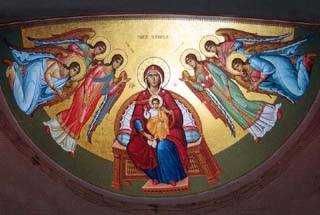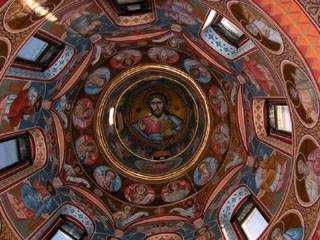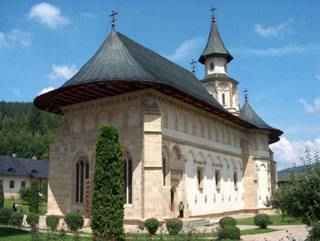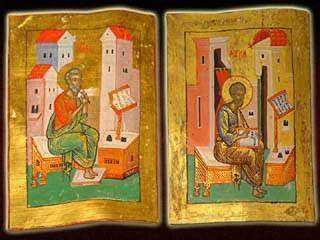According to historians this here is the very first place of worship built by Stephen the Great, in 1466, a year after he had conquered Chilia, by that the ruler giving thanks to the Allmighty for the help He had given the armies. It would only be a beginning for Stephen the Great, who over the course of his lengthy reign would build many more monasteries and churches, but was an important one. For Putna Monastery is today of the best known, most beloved and most important places of worship in Romania, and draws every year pilgrims from all over the country.

Altar Painting
The building was completed by 1469 and was consecrated in 1470, when several other buildings were added to the complex, as well as walls and defensive tower, to protect the sacred place from any harm. All in all, everything was finished in 1481, and the long history of this beautiful place of worship began. It was at that time one of the most beautiful places, the church being painted and decorated by artists, stonemasons and artisans brought over from Transilvania, many of the sacred artefacts being made out of pure gold. The service for the consecration was held by 64 priests, and over the next years Stephen the Great will help the monastery a lot, making several donations to it. For example, in 1502 and 1503 he donated several villages with all their wealth to the monastery. Eventually, Stephen the Great would be burried here, and later many member of his family, as the monastery gained even more importance that way.
Unfortunatelly, it's history wasn't without critical and even dramatic moments. Just a few years after it's completion it was severely damaged in a powerfull fire, being rebuilt afterwards. Another conflagration damaged the complex in 1536, and ruler Alexandru Lapusneanu restored it and made it even more beautiful. Even with this works of restoration, in the 17th century the church was demolished and rebuilt from the foundations up, redecorated and repainted, the very church which can be admired today. Over the course of the next centuries, it would be several times damaged and rebuilt, by fire and earthquakes, but each and everytime the masters knew how to bring back it's former beauty.

Tower Painting Putna
But Putna Monastery wasn't just an important place of worship, but also a beautiful architectural and artistic creation, as the rich decorations in stone, terracotta, as well as the paintings, proved that the artists really gave their best. Keeping largely over the various restorations the original architectural style, it would prove to be a source of inspiration for other churches in the region. The church we see today, built in 1654 - 1662, conserves the general style, foundations and some of the lower part of the wall, with minor modifications. Unfortunatelly, all that was kept from the rich 15th century decorations is the porch, a monumental work of art. Inside you can also admire the iconostasis carved in wood, dating from the 18th century.

Also, a very important element of the complex, still in existence from the era of Stephen the Great, is the Treasury Tower / Money Tower, a strong and impressive stone structure, which also helps proving that Putna was initially a strong fortress.
This place, like many others Moldavian monasteries, would prove to be an important center for Romanian culture in the middle ages, and even after 1467 scribes and calligraphers gathered here to study, works and share their experiences, and miniature painters soon followed. It wasn't long before some of the monks at Putna Monastery began learning the arts of embroidery, icon making, weaving, jewelery making, wood sculpting, book-binding and on, and on. More than that, they proved to be exceptional craftsmen and soon were admired by all. Several such works of art were created here, of major importance being, of course, the sacred books, such as the Four Gospels, a wonderful work of publishing art, with drawings, miniature paintings, carefully chosen and executed caligraphy. The Putna Monastery also housed a prestigious school, where after the middle of the 15ht century Grammar, Rhetoric and Logic classes were held, and it would be so until the end of the 16th century.

Four Gospels
Putna Monastery is by all means a must-visit for any tourist who comes to Romania, a beautiful and well preserved place of worship, a place where one could find essential information about the past and importance that monasteries and Christian belief had in the history of Romania.
Photo : putna.ro
October 2008

































